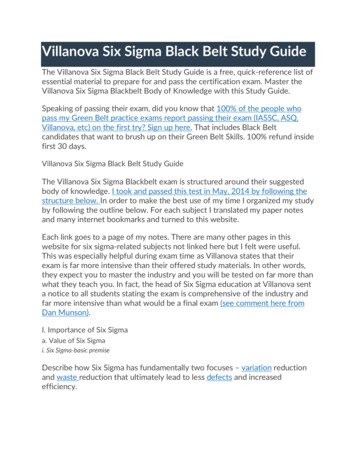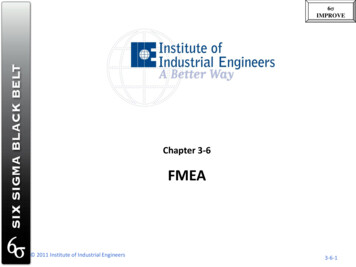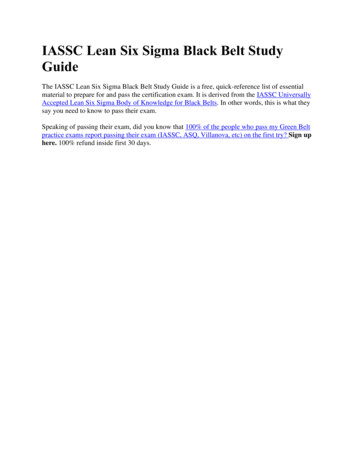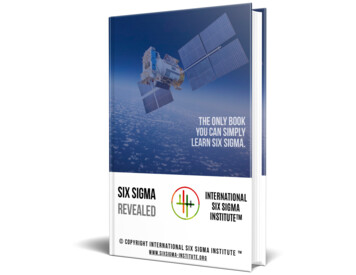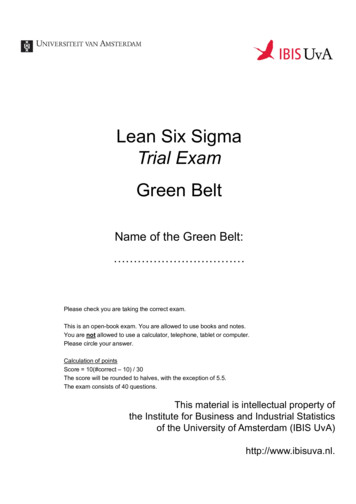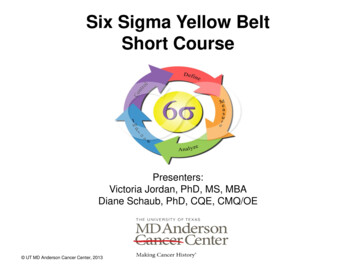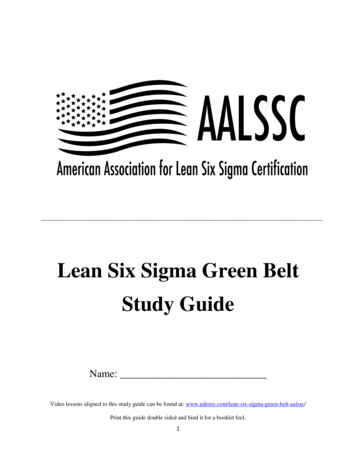
Transcription
CSSBBCERTIFIEDSIX SIGMA BLACK BELTQuality excellence to enhance your careerand boost your organization’s bottom lineasq.org/cert
Certification from ASQ is considered a mark of qualityexcellence in many industries. It helps you advance yourcareer and boosts your organization’s bottom line throughyour mastery of quality skills. Becoming certified as aSix Sigma Black Belt confirms your commitment to qualityand the positive impact it will have on your organization.ExaminationEach certification candidateis required to pass a writtenexamination that consists ofmultiple-choice questions thatmeasure comprehension ofthe body of knowledge.2Certified Six Sigma Black Belt
INFORMATIONCertified Six Sigma Black BeltThe Certified Six Sigma Black Belt (CSSBB) is a professional who can explainSix Sigma philosophies and principles, including supporting systems and tools.A Black Belt should demonstrate team leadership, understand team dynamics,and assign team member roles and responsibilities. Black Belts have a thoroughunderstanding of all aspects of the DMAIC model in accordance with Six Sigmaprinciples. They have basic knowledge of lean enterprise concepts, are able toidentify nonvalue-added elements and activities, and are able to use specific tools.CSSBBExperience RequiredComputer Delivered - the CSSBBexamination is a one-part,165-question, four-and-a-half-hourexam and is offered in English only.One hundred and fifty questions arescored and 15 are unscored.Six Sigma Black Belt requires twocompleted projects with signedaffidavits, or one completed projectwith a signed affidavit and threeyears of work experience, in oneor more areas of the Six SigmaBlack Belt Body of Knowledge.Paper and Pencil – The CSSBBexamination is a one-part,150-question, four-hour examand is offered in English only.For comprehensive exam information on Six Sigma Black Belt certification,visit asq.org/cert.Certified Six Sigma Black Belt3
Minimum ExpectationsOrganization-widePlanning and Deployment Will understand how to deploySix Sigma within a project. Will be able to implement toolsand techniques to deploy strategicdirections for initiatives. Will understand the roles andresponsibilities for Six Sigmaprojects and how each groupinfluences project deployment,and will be able to supportcommunications about theproject deployment. Will be able to apply operationalchange management techniqueswithin their defined scopeor domain.Organizational ProcessManagement and Measures Will be able to define varioustypes of benchmarking.Define Will be able to select datacollection methods and collectvoice of the customer data,and use customer feedback todetermine customer requirements. Will understand the elementsof a project charter (problemstatement, scope, goals, etc.)and be able to use various toolsto track the project progress.Measure Will be able to define and useprocess flow metrics and analysistools to indicate the performanceof a process. Will be able to develop andimplement data collection plans,and use techniques in sampling,data capture, and processing tools. Will be able to describe varioustypes of performance measures,and select an appropriate financialmeasure for a given situation andcalculate its result. Will be able to define and describemeasurement system analysis tools.Team Management Will be able to calculatestatistical and processcapability indices. Will understand the componentsand techniques used inmanaging teams, including timemanagement, planning anddecision-making tools, teamformation, motivational techniquesand factors that demotivate ateam, and performance evaluationand reward. Will be able to describe elementsthat can result in a team’s success.4 Will be able to use appropriatetechniques to overcome variousgroup dynamics challenges.Certified Six Sigma Black Belt Will apply basic probabilityconcepts and understandvarious distributions.Analyze Will be able to analyze theresults of correlation andregression analyses. Will be able to definemultivariate tools. Will be able to performhypothesis tests for means,variances, and proportions,and analyze their results.
Will understand the componentsand concepts for ANOVA, chisquare, contingency tables, andnonparametric tests. Will understand the elements andpurpose of FMEA and use rootcause analysis tools. Will be able to identify andinterpret the seven classic wastes. Will be able to use gapanalysis tools.Improve Will be able to define and applydesign of experiments (DOE)principles, and distinguish amongthe various types of experiments. Will be able to apply various leantools and techniques to eliminatewaste and reduce cycle time. Will understand how to implementan improved process and how toanalyze and interpret risk studies.Control Will be able to apply, use, andanalyze the various statisticalprocess control (SPC) techniques. Will understand total productivemaintenance (TPM) and visualfactory concepts. Will be able to develop controlplans and use various tools tomaintain and sustain improvements.Design For Six Sigma (DFSS)Framework and Methodologies Will understand common DFSSand DFX methodologies, andelements of robust designs.Certified Six Sigma Black Belt5
BODY OF KNOWLEDGECertified Six Sigma Black Belt (CSSBB)Topics in this body of knowledge (BoK) include additional detailin the form of subtext explanations and the cognitive level at whichtest questions will be written. This information will provide guidancefor the candidate preparing to take the exam. The subtext is notintended to limit the subject matter or be all-inclusive of what mightbe covered in an exam. It is meant to clarify the type of content tobe included in the exam. The descriptor in parentheses at the endof each entry refers to the maximum cognitive level at which thetopic will be tested. A complete description of cognitive levels isprovided at the end of this document.I. Organization-WidePlanning and Deployment(Questions 12)A. Organization-wide Considerations1. Fundamentals of Six Sigmaand lean methodologiesDefine and describe the value,foundations, philosophy, history,and goals of these approaches,and describe the integration andcomplementary relationshipbetween them. (Understand)2. Six Sigma, lean, and continuousimprovement methodologiesDescribe when to use Six Sigmainstead of other problem-solvingapproaches, and describe theimportance of aligning Six Sigmaobjectives with organizationalgoals. Describe screening criteriaand how such criteria can beused for the selection of Six Sigmaprojects, lean initiatives, and othercontinuous improvement methods.(Apply)6Certified Six Sigma Black Belt3. Relationships amongbusiness systems and processesDescribe the interactiverelationships among businesssystems, processes, and internaland external stakeholders, and theimpact those relationships have onbusiness systems. (Understand)4. Strategic planning anddeployment for initiativesDefine the importance of strategicplanning for Six Sigma projectsand lean initiatives. Demonstratehow hoshin kanri (X-matrix),portfolio analysis, and other toolscan be used in support of strategicdeployment of these projects.Use feasibility studies, SWOTanalysis (strengths, weaknesses,opportunities, and threats), PESTanalysis (political, economic,social, and technological)and contingency planningand business continuity planningto enhance strategic planningand deployment. (Apply)
B. Leadership1. Roles and responsibilitiesDescribe the roles andresponsibilities of executiveleadership, champions, sponsors,process owners, Master BlackBelts, Black Belts, and GreenBelts in driving Six Sigma andlean initiatives. Describe howeach group influences projectdeployment in terms of providingor managing resources, enablingchanges in organizationalstructure, and supportingcommunications about thepurpose and deployment ofthe initiatives. (Understand)2. Organizational roadblocksand change managementDescribe how an organization’sstructure and culture can impactSix Sigma projects. Identifycommon causes of Six Sigmafailures, including lack ofmanagement support and lackof resources. Apply changemanagement techniques, includingstakeholder analysis, readinessassessments, and communicationplans to overcome barriers anddrive organization-wide change.(Apply)II. O rganizational ProcessManagement andMeasures (10 Questions)A. Impact on StakeholdersDescribe the impact Six Sigma projectscan have on customers, suppliers, andother stakeholders. (Understand)B. BenchmarkingDefine and distinguish betweenvarious types of benchmarking,e.g., best practices, competitive,collaborative, breakthrough. Selectmeasures and performance goals forprojects resulting from benchmarkingactivities. (Apply)C. Business Measures1. Performance measuresDefine and describe balancedscorecard, key performanceindicators (KPIs), customer loyaltymetrics, and leading and laggingindicators. Explain how to createa line of sight from performancemeasures to organizationalstrategies. (Analyze)2. Financial measuresDefine and use revenue growth,market share, margin, net presentvalue (NPV), return on investment(ROI), and cost benefit analysis(CBA). Explain the differencebetween hard cost measures(from profit and loss statements)and soft cost benefits of costavoidance and reduction. (Apply)III. T eam Management(18 Questions)A. Team Formation1. Team types and constraintsDefine and describe variousteams, including virtual, crossfunctional, and self-directed.Determine what team type willwork best for a given a set ofconstraints, e.g., geography,technology availability, staffschedules, time zones. (Apply)2. Team roles and responsibilitiesDefine and describe variousteam roles and responsibilitiesfor leader, facilitator, coach, andindividual member. (Understand)3. Team member selection criteriaDescribe various factors thatinfluence the selection of teammembers, including the ability toinfluence, openness to change,required skill sets, subject matterexpertise, and availability. (Apply)4. Team success factorsIdentify and describe the elementsnecessary for successful teams,e.g., management support, cleargoals, ground rules, timelines.(Apply)Certified Six Sigma Black Belt7
B. Team Facilitation1. Motivational techniquesDescribe and apply techniques tomotivate team members. Identifyfactors that can demotivate teammembers and describe techniquesto overcome them. (Apply)2. Team stages of developmentIdentify and describe the classicstages of team development:forming, storming, norming,performing, and adjourning.(Apply)3. Team communicationDescribe and explain the elementsof an effective communicationplan, e.g., audience identification,message type, medium, frequency.(Apply)4. Team leadership modelsDescribe and select appropriateleadership approaches (e.g.,direct, coach, support, delegate)to ensure team success. (Apply)C. Team Dynamics1. Group behaviorsIdentify and use various conflictresolution techniques (e.g.,8Certified Six Sigma Black Beltcoaching, mentoring, intervention)to overcome negative groupdynamics, including dominant andreluctant participants, groupthink,rushing to finish, and digressions.(Evaluate)2. Meeting managementSelect and use various meetingmanagement techniques, includingusing agendas, starting on time,requiring pre-work by attendees,and ensuring that the right peopleand resources are available.(Apply)3. Team decision-making methodsDefine, select, and use varioustools (e.g., consensus, nominalgroup technique, multi-voting) fordecision making. (Apply)D. Team Training1. Needs assessmentIdentify the steps involved toimplement an effective trainingcurriculum: identify skills gaps,develop learning objectives,prepare a training plan, anddevelop training materials.(Understand)
2. DeliveryDescribe various techniquesused to deliver effective training,including adult learning theory,soft skills, and modes of learning.(Understand)3. EvaluationDescribe various techniquesto evaluate training, includingevaluation planning, feedbacksurveys, pre-training and posttraining testing. (Understand)IV. Define (20 Questions)A. Voice of the Customer1. Customer IdentificationIdentify and segment customers andshow how a project will impactboth internal and external customers.(Apply)2. Customer data collectionIdentify and select appropriatedata collection methods (e.g.,surveys, focus groups, interviews,observations) to gather voice ofthe customer data. Ensure thedata collection methods used arereviewed for validity and reliability.(Analyze)3. Customer requirementsDefine, select, and applyappropriate tools to determinecustomer needs and requirements,including critical-to-X (CTX when“X” can be quality, cost, safety,etc.), CTQ tree, quality functiondeployment (QFD), supplier, input,process, output, customer (SIPOC),and Kano model. (Analyze)B. Business Caseand Project Charter1. Business caseDescribe business case justificationused to support projects.(Understand)2. Problem statementDevelop a project problemstatement and evaluate it inrelation to baseline performanceand improvement goals. (Evaluate)3. Project scopeDevelop and review projectboundaries to ensure that theproject has value to the customer.(Analyze)4. Goals and objectivesIdentify specific, measureable,actionable, relevant, and timebound (SMART) goals andobjectives on the basis of theproject’s problem statement andscope. (Analyze)5. Project performance measurementsIdentify and evaluate performancemeasurements (e.g., cost, revenue,delivery, schedule, customersatisfaction) that connect criticalelements of the process to keyoutputs. (Analyze)6. Project charter reviewExplain the importance of havingperiodic project charter reviewswith stakeholders. (Understand)C. Project Management (PM) ToolsIdentify and use the following PM toolsto track projects and document theirprogress. (Evaluate)1. Gantt charts2. Toll-gate reviews3. Work breakdownstructure (WBS)4. RACI model (responsible,accountable, consulted,and informed)D. Analytical ToolsIdentify and use the followinganalytical tools throughout the DMAICcycle. (Apply)1. Affinity diagrams2. Tree diagrams3. Matrix diagrams4. Prioritization matrices5. Activity network diagramsCertified Six Sigma Black Belt9
V. Measure (25 Questions)A. Process Characteristics1. Process flow metricsIdentify and use process flowmetrics (e.g., work in progress(WIP), work in queue (WIQ),touch time, takt time, cycletime, throughput) to determineconstraints. Describe the impactthat “hidden factories” can haveon process flow metrics. (Analyze)2. Process analysis toolsSelect, use, and evaluate varioustools, e.g., value stream maps,process maps, work instructions,flowcharts, spaghetti diagrams,circle diagrams, gemba walk.(Evaluate)B. Data Collection1. Types of dataDefine, classify, and distinguishbetween qualitative and quantitativedata, and continuous and discretedata. (Evaluate)2. Measurement scalesDefine and use nominal, ordinal,interval, and ratio measurementscales. (Apply)3. SamplingDefine and describe samplingconcepts, including representativeselection, homogeneity, bias,accuracy, and precision. Determinethe appropriate sampling method(e.g., random, stratified, systematic,subgroup, block) to obtain validrepresentation in various situations.(Evaluate)4. Data collection plans and methodsDevelop and implement datacollection plans that includedata capture and processingtools, e.g., check sheets, datacoding, data cleaning (imputationtechniques). Avoid data collectionpitfalls by defining the metrics tobe used or collected, ensuringthat collectors are trained in thetools and understand how thedata will be used, and checkingfor seasonality effects. (Analyze)10 Certified Six Sigma Black BeltC. Measurement Systems1. Measurement systemanalysis (MSA)Use gauge repeatability andreproducibility (R&R) studiesand other MSA tools (e.g., bias,correlation, linearity, precisionto tolerance, percent agreement)to analyze measurement systemcapability. (Evaluate)2. Measurement systemsacross the organizationIdentify how measurement systemscan be applied to marketing,sales, engineering, research anddevelopment (R&D), supply chainmanagement, and customersatisfaction data. (Understand)3. MetrologyDefine and describe elements ofmetrology, including calibrationsystems, traceability to referencestandards, and the control andintegrity of measurement devicesand standards. (Understand)D. Basic Statistics1. Basic statistical termsDefine and distinguish betweenpopulation parameters and samplestatistics, e.g., proportion, mean,standard deviation. (Apply)2. Central limit theoremExplain the central limit theorem andits significance in the application ofinferential statistics for confidenceintervals, hypothesis tests, andcontrol charts. (Understand)3. Descriptive statisticsCalculate and interpret measuresof dispersion and central tendency.(Evaluate)4. Graphical methodsIdentify various elements of auditclosure and any criteria that havenot been met and would prevent anaudit from being closed. (Evaluate)5. Valid statistical conclusionsDistinguish between descriptiveand inferential statistical studies.Evaluate how the results ofstatistical studies are used todraw valid conclusions. (Evaluate)
E. Probability1. Basic conceptsDescribe and apply probabilityconcepts, e.g., independence,mutually exclusive events,addition and multiplicationrules, conditional probability,complementary probability, jointoccurrence of events. (Apply)2. DistributionsDescribe, interpret, and usevarious distributions, e.g., normal,Poisson, binomial, chi square,Student’s t, F, hypergeometric,bivariate, exponential, lognormal,Weibull. (Evaluate)F. Process Capability1. Process capability indicesDefine, select, and calculateCp and Cpk. (Evaluate)2. Process performance indicesDefine, select, and calculate Pp,Ppk, Cpm, and process sigma.(Evaluate)3. General process capability studiesDescribe and apply elementsof designing and conductingprocess capability studies relativeto characteristics, specifications,sampling plans, stability, andnormality. (Evaluate)4. Process capabilityfor attributes dataCalculate the process capabilityand process sigma level forattributes data. (Apply)5. Process capabilityfor non-normal dataIdentify non-normal data anddetermine when it is appropriateto use Box-Cox or othertransformation techniques. (Apply)6. Process performancevs. specificationDistinguish between naturalprocess limits and specificationlimits. Calculate processperformance metrics, e.g.,percent defective, parts permillion (PPM), defects per millionopportunities (DPMO), defects perunit (DPU), throughput yield, rolledthroughput yield (RTY). (Evaluate)7. Short-term andlong-term capabilityDescribe and use appropriateassumptions and conventions whenonly short-term data or only longterm data are available. Interpretthe relationship between short-termand long-term capability. (Evaluate)VI. A nalyze (22 Questions)A. Measuring and ModelingRelationships Between Variables1. Correlation coefficientCalculate and interpret thecorrelation coefficient and itsconfidence interval, and describethe difference between correlationand causation. (Evaluate)2. Linear regressionCalculate and interpretregression analysis, and applyand interpret hypothesis testsfor regression statistics. Use theregression model for estimationand prediction, analyze theuncertainty in the estimate, andperform a residuals analysis tovalidate the model. (Evaluate)3. Multivariate toolsUse and interpret multivariate tools(e.g., factor analysis, discriminantanalysis, multiple analysis ofvariance (MANOVA)) to investigatesources of variation. (Evaluate)B. Hypothesis Testing1. TerminologyDefine and interpret the significancelevel, power, type I, and type IIerrors of statistical tests. (Evaluate)2. Statistical vs. practical significanceDefine, compare, and interpretstatistical and practical significance.(Evaluate)Certified Six Sigma Black Belt 11
3. Sample sizeCalculate sample size for commonhypothesis tests: equality of meansand equality of proportions.(Apply)4. Point and interval estimatesDefine and distinguish betweenconfidence and prediction intervals.Define and interpret the efficiencyand bias of estimators. Calculatetolerance and confidence intervals.(Evaluate)5. Tests for means,variances, and proportionsUse and interpret the resultsof hypothesis tests for means,variances, and proportions.(Evaluate)6. Analysis of variance (ANOVA)Select, calculate, and interpret theresults of ANOVAs. (Evaluate)7. Goodness-of-fit (chi square) testsDefine, select, and interpret theresults of these tests. (Evaluate)8. Contingency tablesSelect, develop, and usecontingency tables to determinestatistical significance. (Evaluate)9. Nonparametric testsUnderstand the importance of theKruskal-Wallis and Mann-Whitneytests and when they should beused. (Understand)C. Failure Mode andEffects Analysis (FMEA)Describe the purpose and elements ofFMEA, including risk priority number(RPN), and evaluate FMEA results forprocesses, products, and services.Distinguish between design FMEA(DFMEA) and process FMEA (PFMEA),and interpret their results. (Evaluate)D. Additional Analysis Methods1. Gap analysisAnalyze scenarios to identifyperformance gaps, and comparecurrent and future states usingpredefined metrics. (Analyze)12 Certified Six Sigma Black Belt2. Root cause analysisDefine and describe the purposeof root cause analysis, recognizethe issues involved in identifying aroot cause, and use various tools(e.g., 5 whys, Pareto charts, faulttree analysis, cause and effectdiagrams) to resolve chronicproblems. (Analyze)3. Waste analysisIdentify and interpret the sevenclassic wastes (overproduction,inventory, defects, over-processing,waiting, motion, transportation) andresource under-utilization. (Analyze)VII. Improve (21 Questions)A. Design of Experiments (DOE)1. TerminologyDefine basic DOE terms, e.g.,independent and dependentvariables, factors and levels,response, treatment, error,nested. (Understand)2. Design principlesDefine and apply DOE principles,e.g., power, sample size,balance, repetition, replication,order, efficiency, randomization,blocking, interaction, confounding,resolution. (Apply)3. Planning experimentsPlan and evaluate DOEs bydetermining the objective, selectingappropriate factors, responses,and measurement methods, andchoosing the appropriate design.(Evaluate)4. One-factor experimentsDesign and conduct completelyrandomized, randomized block,and Latin square designs, andevaluate their results. (Evaluate)5. Two-level fractionalfactorial experimentsDesign, analyze, and interpretthese types of experiments, anddescribe how confounding canaffect their use. (Evaluate)
6. Full factorial experimentsDesign, conduct, and analyze thesetypes of experiments. (Evaluate)B. Lean Methods1. Waste eliminationSelect and apply tools andtechniques for eliminating orpreventing waste, e.g., pullsystems, kanban, 5S, standardwork, poka-yoke. (Analyze)2. Cycle-time reductionUse various tools and techniques forreducing cycle time, e.g., continuousflow, single-minute exchange ofdie (SMED), heijunka (productionleveling). (Analyze)3. KaizenDefine and distinguish betweenkaizen and kaizen blitz anddescribe when to use eachmethod. (Apply)4. Other improvementtools and techniquesIdentify and describe howother process improvementmethodologies are used, e.g.,theory of constraints (TOC),overall equipment effectiveness(OEE). (Understand)C. ImplementationDevelop plans for implementingproposed improvements, includingconducting pilot tests or simulations,and evaluate results to select theoptimum solution. (Evaluate)VIII. Control (15 Questions)A. Statistical Process Control (SPC)1. ObjectivesExplain the objectives of SPC,including monitoring and controllingprocess performance, trackingtrends, runs, and reducing variationwithin a process. (Understand)2. Selection of variablesIdentify and select critical processcharacteristics for control chartmonitoring. (Apply)3. Rational subgroupingDefine and apply the principle ofrational subgrouping. (Apply)Certified Six Sigma Black Belt 13
4. Control chart selectionSelect and use control chartsin various situations: X-R, X-s,individual and moving range (ImR),p, np, c, u, short-run SPC, andmoving average. (Apply)5. Control chart analysisInterpret control charts anddistinguish between commonand special causes using rulesfor determining statistical control.(Analyze)B. Other Controls1. Total productive maintenance (TPM)Define the elements of TPM anddescribe how it can be used toconsistently control the improvedprocess. (Understand)2. Visual controlsDefine the elements of visualcontrols (e.g., pictures ofcorrect procedures, color-codedcomponents, indicator lights),and describe how they can helpcontrol the improved process.(Understand)C. Maintain Controls1. Measurement system reanalysisReview and evaluate measurementsystem capability as processcapability improves, and ensure thatmeasurement capability is sufficientfor its intended use. (Evaluate)2. Control planDevelop a control plan to maintainthe improved process performance,enable continuous improvement,and transfer responsibility from theproject team to the process owner.(Apply)D. Sustain Improvements1. Lessons learnedDocument the lessons learnedfrom all phases of a projectand identify how improvementscan be replicated and appliedto other processes in theorganization. (Apply)14 Certified Six Sigma Black Belt2. DocumentationDevelop or modify documentsincluding standard operatingprocedures (SOPs), workinstructions, and control plans toensure that the improvements aresustained over time. (Apply)3. Training for processowners and staffDevelop and implement trainingplans to ensure consistent executionof revised process methods andstandards to maintain processimprovements. (Apply)4. Ongoing evaluationIdentify and apply tools (e.g.,control charts, control plans)for ongoing evaluation of theimproved process, includingmonitoring leading indicators,lagging indicators, andadditional opportunities forimprovement. (Apply)IX. D esign for Six Sigma(DFSS) Frameworkand Methodologies(7 Questions)A. Common DFSS MethodologiesIdentify and describe define,measure, analyze, design, andvalidate (DMADV) and define,measure, analyze, design, optimize,and validate (DMADOV). (Understand)B. Design for X (DFX)Describe design constraints,including design for cost, designfor manufacturability (producibility),design for test, and design formaintainability. (Understand)C. Robust DesignsDescribe the elements of robustproduct design, tolerance design,and statistical tolerancing.(Understand)
LEVELS OF COGNITIONBased on Bloom’s Taxonomy—Revised (2001)In addition to content specifics, the subtext for each topic in this BoK alsoindicates the intended complexity level of the test questions for that topic.These levels are based on “Levels of Cognition” (from Bloom’s Taxonomy—Revised, 2001) and are presented below in rank order, from least complexto most complex.REMEMBER Recall or recognize terms,definitions, facts, ideas, materials, patterns,sequences, methods, principles, etc.UNDERSTAND Read and understanddescriptions, communications, reports,tables, diagrams, directions, regulations, etc.APPLY Know when and how to useideas, procedures, methods, formulas,principles, theories, etc.ANALYZE Break down information intoits constituent parts and recognize theirrelationship to one another and how theyare organized; identify sublevel factors orsalient data from a complex scenario.EVALUATE Make judgments about thevalue of proposed ideas, solutions, etc.,by comparing the proposal to specificcriteria or standards.CREATE Put parts or elements togetherin such a way as to reveal a pattern orstructure not clearly there before; identifywhich data or information from a complexset is appropriate to examine further orfrom which supported conclusions canbe drawn.Visit asq.org/cert for comprehensive exam information.
Enhance your careerwith ASQ certification today!Visit asq.org/cert for additionalcertification information including: Applications Available certifications andinternational language options Reference materials Study guides and test-taking tips Comprehensive exam information ASQ sections International contacts EndorsementsItem B1226
6 Certified Six Sigma Black Belt. I Wde - noi ti az gaOi r n Planning and Deployment (Questions 12) A. Organization-wide Considerations 1. Fundamentals of Six Sigma and lean methodologies Define and describe the value, foundat


